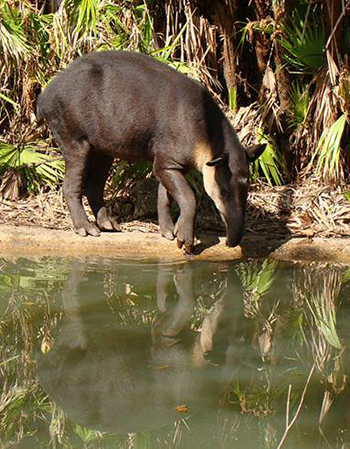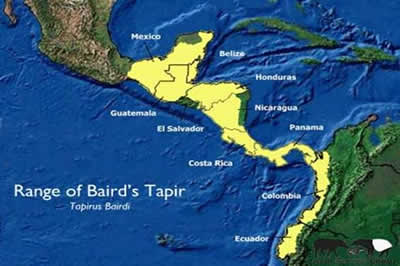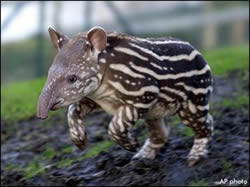Baird's Tapir
Tapirus bairdii
Other Names: Macho del Monte, Mountain Cow

Taxonomy
Kingdom: Anamalia
Phylum: Chordata
Class: Mammalia
Order: Perrisodactyla
Family: Tapiridae
Quick Facts
- Body length: 6.5-6.7 feet long
- Body weight: Up to 600 lbs
- Shoulder Height: Up to four ft
- National Animal of Belize
- Excellent sense of smell/hearing
- Poor eye-sight
- Life span: Can live over 30 years
Ecology/ Description
The Baird’s Tapir is the largest indigenous land animals in Central America and are most active at night. They are related to the primitive horse and rhinoceros. They have a massive body that is rounded in the back and tapering in the front, which helps them move through heavy vegetation. They have thick leathery skin and a reddish-brown colored coat that can turn into a white coloring toward the neck and jaw region. They have a distinctive prehensile-like snout formed from the tissues of the upper lip and nose that gives them an excellent sense of smell that is also used for ripping leaves off branches and grabbing fruit. The tapir’s feet are unique as well, with four toes on the front feet and three toes on the back, that work great for swimming or maneuvering through the forest. They can be found from the Oaxaca Province in Mexico through Central America to the western side of the Andean mountain range in Colombia and enjoy swampy areas or rainforests, but do also reside in mountainous regions. The tell-tale sign of Baird's tapir are repeatedly used paths through the jungle, which the tapirs mark regularly.

Maps by Carlos Pedraza, TSG, 2008
Diet
The tapir is well suited for swallowing twigs, nuts and other tough plant tissues found throughout river basins and have no problem taking down thorns and insects that happen to be in the way. Common foods include the bromeliads and their berries, leaves of tropical trees, ferns and palm fruits and hearts. It is also said that they crave salt and have a strong taste for bananas. The tapir will spend about 90 % of its time looking for food which helps maintain its massive size. It can also consume grasses, aquatic vegetation, leaves, buds and fruit from low growing shrubs. Some have been known to consume up to 75 lbs of food in just one night.
Estimated Population
It is thought that there are less than 3300 tapirs left in Belize due to habitat loss and poaching. Higher numbers are found in National Park that are bordered by forest reserves. The location of this ideal tapir habitat is remote, making the absence of human pressure perfect for secondary growth vegetation needed for their living space and food consumption.
Conservation Status
Baird's tapir is classified as an endangered species.
 Activity
Activity
Primarily becomes active at dusk and throughout the night. It then makes its way to dense vegetation in the morning to avoid predators and the day time heat. However when the tapir does decide to make an appearance during the day it is usually to enjoy its time in a water hole or even to eat again. Tapirs are not particularly territorial, but are avid scent markers; continually defecating or spraying as they walk around eating or even when relaxing in water. Territories are roughly 1 sq km to 3/sq km (Eisenberg, 1997). Females’ ranges tend to be slightly larger than males.
Reproduction
The gestation period of the Baird’s Tapir is between 390-400 days where they commonly give birth to one offspring (rarely two). The young of the adult tapirs are beautifully marked with fused stripe markings of light and dark brown that keeps them camouflaged from predators. The infant will lose its unique markings and receive the more solid reddish-brown adult coloring around 11 months.
Personal Interest
I enjoy learning about all animals, but I find more motivation behind getting to know about one more than the other when they are endangered, so I can better understand peoples’ roles in helping them. Also, before going to Belize, I figured if there was one animal I should know a little something about, the most obvious choice would be its national animal.
References:
Please note that the following references may have either been removed or relocated by the webpage owners since the time this student report was created.
BROOKS, D.; BODMER, R.E.; MATOLA, S (compilers). 1997. Tapirs – Status Survey and Conservation Action Plan. (English, Spanish, Portuguese.) IUCN/SSC Tapir Specialist Group. IUCN, Gland, Switzerland and Cambridge,UK.viii+164pp. Dirección en la Red. http://www.tapirback.com/tapirgal/iucn-ssc/tsg/action97/cover.htm
Eisenberg, J. F., C. P. Groves, and K. MacKinnon. 1990. Tapirs. In Grzimek's Encyclopedia of Mammals. Edited by S. P. Parker. New York: McGraw-Hill. Volume 4, pp. 597-608.
Matola, S., A. D. Cuarón, and H. Rubio-Torgler. 1997. Status and action plan of Baird's tapir (Tapirus bairdi). In Tapirs - Status Survey and Conservation Action Plan. IUCN/SSC Tapir Specialist Group. Compiled by D. M. Brooks, R. E. Bodmer, and S. Matola. IUCN, Gland, Switzerland and Cambridge, UK. Available online at http://www.tapirback.com/tapirgal/iucn-ssc/tsg/action97/default.htm
Castellanos, A., Foerester, C., Lizcano, D.J., Naranjo, E., Cruz-Aldan, E., Lira-Torres, I., Samudio, R., Matola, S., Schipper, J. & Gonzalez-Maya. J. 2008. Tapirus bairdii. In: IUCN 2011. IUCN Red List of Threatened Species. Version 2011.2.< www.iucnredlist.org>. Downloaded on 30 May 2012.
Pictures
http://www.tapirs.org/tapirs/bairds.html
http://akrainforest10.pbworks.com/w/page/24296712/Tapir
http://en.wikipedia.org/wiki/File:Bairds-Tapir-Belize-Zoo-2010.jpg